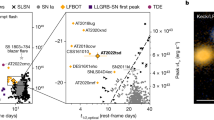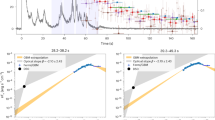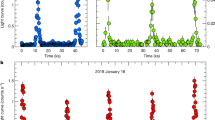Abstract
Hyperluminous optical–ultraviolet flares have been detected in gamma-ray bursts and the luminosity record was held by naked-eye event GRB 080319B. Such flares are widely attributed to internal shock or external reverse shock radiation. Here, with a new method developed to derive reliable photometry from saturated sources of Swift/UVOT, we carry out time-resolved analysis of the initial white-band 150 s exposure of GRB 220101A, a burst at a redshift of 4.618, and report a rapidly evolving optical–ultraviolet flare with a high absolute AB magnitude of −39.4 ± 0.2. In contrast to GRB 080319B, the temporal behaviour of this new flare does not trace the gamma-ray activity. Instead of either internal shocks or reverse shock, this extremely energetic optical–ultraviolet flare is most likely to originate from the refreshed shocks induced by the late-ejected extremely energetic material catching up with the earlier-launched decelerating outflow. This finding reveals the diverse origins of the extremely energetic optical–ultraviolet flares and demonstrates the necessity of high-time-resolution observations at early times.
This is a preview of subscription content, access via your institution
Access options
Access Nature and 54 other Nature Portfolio journals
Get Nature+, our best-value online-access subscription
$29.99 / 30 days
cancel any time
Subscribe to this journal
Receive 12 digital issues and online access to articles
$119.00 per year
only $9.92 per issue
Buy this article
- Purchase on Springer Link
- Instant access to full article PDF
Prices may be subject to local taxes which are calculated during checkout



Similar content being viewed by others
Data availability
The Swift and Fermi data analysed/used in this work are all publicly available at https://heasarc.gsfc.nasa.gov/cgi-bin/W3Browse/.
Code availability
HEASoft code is available at https://heasarc.gsfc.nasa.gov/lheasoft/ and the calibration database (CALDB) is available at https://heasarc.gsfc.nasa.gov/docs/heasarc/caldb/swift/. Fermi-GBM Data Tools is available at https://fermi.gsfc.nasa.gov/ssc/data/analysis/gbm. Bilby is available at https://git.ligo.org/lscsoft/bilby/.
References
Fishman, G. J. & Meegan, C. A. Gamma-ray bursts. Annu. Rev. Astron. Astrophys. 33, 415–458 (1995).
Mészáros, P. Theories of gamma-ray bursts. Annu. Rev. Astron. Astrophys. 40, 137–169 (2002).
Piran, T. The physics of gamma-ray bursts. Rev. Mod. Phys. 76, 1143–1210 (2004).
Kumar, P. & Zhang, B. The physics of gamma-ray bursts & relativistic jets. Phys. Rep. 561, 1–109 (2015).
Mészáros, P. & Rees, M. J. Optical and long-wavelength afterglow from gamma-ray bursts. Astrophys. J. 476, 232–237 (1997).
Akerlof, C. et al. Observation of contemporaneous optical radiation from a γ-ray burst. Nature 398, 400–402 (1999).
Castro-Tirado, A. J. et al. Decay of the GRB 990123 optical afterglow: implications for the fireball model. Science 283, 2069 (1999).
Sari, R. & Piran, T. Predictions for the very early afterglow and the optical flash. Astrophys. J. 520, 641–649 (1999).
Mészáros, P. & Rees, M. J. GRB 990123: reverse and internal shock flashes and late afterglow behaviour. Mon. Not. R. Astron. Soc. 306, L39–L43 (1999).
Fan, Y.-Z., Dai, Z.-G., Huang, Y.-F. & Lu, T. Optical flash of GRB 990123: constraints on the physical parameters of the reverse shock. Chin. J. Astron. Astrophys. 2, 449–453 (2002).
Zhang, B., Kobayashi, S. & Mészáros, P. Gamma-ray burst early optical afterglows: implications for the initial Lorentz factor and the central engine. Astrophys. J. 595, 950–954 (2003).
Racusin, J. L. et al. Broadband observations of the naked-eye γ-ray burst GRB080319B. Nature 455, 183–188 (2008).
Fan, Y.-Z., Zhang, B. & Wei, D.-M. Naked-eye optical flash from gamma-ray burst 080319B: tracing the decaying neutrons in the outflow. Phys. Rev. D 79, 021301 (2009).
Li, Z. & Waxman, E. Prompt optical emission from residual collisions in gamma-ray burst outflows. Astrophys. J. Lett. 674, L65 (2008).
Roming, P. W. A. et al. A large catalog of homogeneous ultra-violet/optical GRB afterglows: temporal and spectral evolution. Astrophys. J. Suppl. Ser. 228, 13 (2017).
Page, M. J. et al. The use and calibration of read-out streaks to increase the dynamic range of the Swift Ultraviolet/Optical Telescope. Mon. Not. R. Astron. Soc. 436, 1684–1693 (2013).
Poole, T. S. et al. Photometric calibration of the Swift ultraviolet/optical telescope. Mon. Not. R. Astron. Soc. 383, 627–645 (2008).
Kuin, N. P. M. & Rosen, S. R. The measurement errors in the Swift-UVOT and XMM-OM. Mon. Not. R. Astron. Soc. 383, 383–386 (2008).
Tohuvavohu, A. et al. GRB 220101A: Swift detection of a burst with a bright optical counterpart. GRB Coord. Netw. Circ. No. 31347 (2022).
Lesage, S. & Meegan, C. Fermi Gamma-ray Burst Monitor Team. GRB 220101A: Fermi GBM detection. GRB Coord. Netw. Circ. No. 31360 (2022).
Ursi, A. et al. GRB 220101A: AGILE detection. GRB Coord. Netw. Circ. No. 31354 (2022).
Kuin, N. P. M. & Tohuvavohu, A. Swift/UVOT Team. GRB 220101: Swift/UVOT detection. GRB Coord. Netw. Circ. No. 31351 (2022).
Fu, S. Y., Zhu, Z. P., Xu, D., Liu, X. & Jiang, S. Q. GRB 220101A: Xinglong-2.16m photometry and spectroscopy. GRB Coord. Netw. Circ. No. 31353 (2022).
Fynbo, J. P. U. et al. GRB 220101A: NOT redshift confirmation. GRB Coord. Netw. Circ. No. 31359 (2022).
Atteia, J. L. GRB 220101A : Eiso equals the maximum isotropic GRB energy. GRB Coord. Netw. Circ. No. 31365 (2022).
Tsvetkova, A. et al. Konus-Wind detection of GRB 220101A. GRB Coord. Netw. Circ. No. 31433 (2022).
Boër, M. et al. Detection of a Very bright optical flare from the gamma-ray burst GRB 050904 at redshift 6.29. Astrophys. J. Lett. 638, L71–L74 (2006).
Lü, J. et al. Lorentz-factor–isotropic-luminosity/energy correlations of gamma-ray bursts and their interpretation. Astrophys. J. 751, 49 (2012).
Fan, Y.-Z., Wei, D.-M., Zhang, F.-W. & Zhang, B.-B. The photospheric radiation model for the prompt emission of gamma-ray bursts: interpreting four observed correlations. Astrophys. J. Lett. 755, L6 (2012).
Wei, D. M., Yan, T. & Fan, Y. Z. The optical flare and afterglow light curve of GRB 050904 at redshift z = 6.29. Astrophys. J. Lett. 636, L69–L72 (2006).
Piran, T. Gamma-ray bursts and the fireball model. Phys. Rep. 314, 575–667 (1999).
Mei, A. et al. Constraints on the Physics of the prompt emission from distant and energetic gamma-ray burst GRB 220101A. Astrophys. J. 941, 82 (2022).
Yu, S.-J., Gonzalez, F., Wei, J.-Y., Zhang, S.-N. & Cordier, B. SVOM: a joint gamma-ray burst detection mission. Chin. Astron. Astrophys. 44, 269–282 (2020).
Fordham, J. L. A., Kawakami, H., Michel, R. M., Much, R. & Robinson, J. R. High time-resolution spectroscopic imaging using intensified CCD detectors. Mon. Not. R. Astron. Soc. 319, 414–418 (2000).
Breeveld, A. A. et al. Further calibration of the Swift ultraviolet/optical telescope. Mon. Not. R. Astron. Soc. 406, 1687–1700 (2010).
Kuin, N. P. M. et al. Calibration of the Swift-UVOT ultraviolet and visible grisms. Mon. Not. R. Astron. Soc. 449, 2514–2538 (2015).
Maselli, A. et al. GRB 130427A: a nearby ordinary monster. Science 343, 48–51 (2014).
Woźniak, P. R. et al. Gamma-ray burst at the extreme: “the naked-eye burst” GRB 080319B. Astrophys. J. 691, 495–502 (2009).
Evans, P. A. et al. An online repository of Swift/XRT light curves of γ-ray bursts. Astron. Astrophys. 469, 379–385 (2007).
Evans, P. et al. Methods and results of an automatic analysis of a complete sample of Swift-XRT observations of GRBs. Mon. Not. R. Astron. Soc. 397, 1177–1201 (2009).
Perley, D. A. GRB 220101A: Liverpool telescope imaging of a high-redshift afterglow. GRB Coord. Netw. Circ. No. 31357 (2022).
Andersen, M. I. et al. VLT identification of the optical afterglow of the gamma-ray burst GRB 000131 at z = 4.50. Astron. Astrophys. 364, L54–L61 (2000).
Thöne, C. C. et al. GRB 100219A with X-shooter - abundances in a galaxy at z =4.7. Mon. Not. R. Astron. Soc. 428, 3590–3606 (2013).
Schlafly, E. F. & Finkbeiner, D. P. Measuring reddening with Sloan Digital Sky Survey stellar spectra and recalibrating SFD. Astrophys. J. 737, 103 (2011).
Planck Collaboration. Planck 2018 results. VI. Cosmological parameters. Astron. Astrophys. 641, A6 (2020).
Fan, Y. Z., Wei, D. M. & Wang, C. F. The very early afterglow powered by ultra-relativistic mildly magnetized outflows. Astron. Astrophys. 424, 477–484 (2004).
Zhang, B. & Kobayashi, S. Gamma-ray burst early afterglows: reverse shock emission from an arbitrarily magnetized ejecta. Astrophys. J. 628, 315–334 (2005).
Geng, J. J., Wu, X. F., Huang, Y. F., Li, L. & Dai, Z. G. Imprints of electron-positron winds on the multiwavelength afterglows of gamma-ray bursts. Astrophys. J. 825, 107 (2016).
Sironi, L., Keshet, U. & Lemoine, M. Relativistic shocks: particle acceleration and magnetization. Space Sci. Rev. 191, 519–544 (2015).
Giannios, D. & Spitkovsky, A. Signatures of a Maxwellian component in shock-accelerated electrons in GRBs. Mon. Not. R. Astron. Soc. 400, 330–336 (2009).
Geng, J.-J., Huang, Y.-F., Wu, X.-F., Zhang, B. & Zong, H.-S. Low-energy spectra of gamma-ray bursts from cooling electrons. Astrophys. J. Suppl. Ser. 234, 3 (2018).
Perley, D. A. GRB 220101A: Additional Liverpool telescope photometry. GRB Coord. Netw. Circ. No. 31425 (2022).
Møller, P. & Jakobsen, P. The Lyman continuum opacity at high redshifts—through the Lyman forest and beyond the Lyman valley. Astron. Astrophys. 228, 299–309 (1990).
Acknowledgements
This work was supported in part by NSFC under grant numbers 12225305, 11921003, 11933010 and 12273113, the China Manned Space Project (grant number NO.CMS-CSST-2021-A12), the Major Science and Technology Project of Qinghai Province (grant number 2019-ZJ-A10) and the Key Research Program of Frontier Sciences (grant number QYZDJ-SSW-SYS024). J.-J.G. was supported by the Youth Innovation Promotion Association (grant number 2023331). S.C. was supported by ASI grant number I/004/11/0.
Author information
Authors and Affiliations
Contributions
Y.-Z.F. and Z.-P.J. launched the project. Z.-P.J., H.Z., Y.W., X.L., S.C. and J.-Y.W. carried out the data analysis. Y.-Z.F., J.-J.G., X.-F.W., D.-M.W. and Z.-P.J. interpreted the data. Z.-P.J., H.Z. and Y.-Z.F. prepared the paper and all authors contributed to discussions. Z.-P.J. and H.Z. contributed equally.
Corresponding author
Ethics declarations
Competing interests
The authors declare no competing interests.
Peer review
Peer review information
Nature Astronomy thanks Rosa Becerra and the other, anonymous, reviewer(s) for their contribution to the peer review of this work.
Additional information
Publisher’s note Springer Nature remains neutral with regard to jurisdictional claims in published maps and institutional affiliations.
Extended data
Extended Data Fig. 1 Swift/UVOT white (WH) band images demonstrating the halo ring photometry method.
Panel (a) is the White band image of GRB 130427A, where the solid circle represents the standard aperture of UVOT with a radius of 5 arcsec. The dotted square region strongly suffered from coincidence loss with a typical side length of ~ 20 arcsec. Dashed annulus with an inner radius of 15 arcsec and an out radius of 25 arcsec is the halo ring region defined in this work, for which the \({\dot{N}}_{{{{\rm{ring}}}}}\) is derived. Panel (b) shows the deep exposure of GRB 220101A field in White band, which reveals 2 faint sources in the halo ring region, hence we masked the annulus region from 95∘ to 150∘, as shown in panel (c). In addition, images of panel (b) and (c) have a pixel scale of 1.004 arcsec/pixel instead of 0.502 arcsec/pixel for other 4 images. Panel (d), (e) and (f) show some images around the peak time of GRB 220101A. We measured count rates in unmasked annulus region and corrected it to the whole annulus region.
Extended Data Fig. 2 The UVOT lightcurves as well as the SEDs of GRB 130427A.
a, In the top panel, the vertical grey regions mark the observation periods of the White filter. Note that the second U-band data is saturated, which was however a detection point in Maselli et al.37 if only event data in the last 6s was measured, hence the filled and the empty green triangles coincide. The shaded colorful regions across photometry points are our interpolation results of light curve. b, The bottom panel presents the optical to ultraviolet SEDs at the White band observation times constructed with the extrapolated UVOT narrow band data. A single power-law spectrum well reproduces the data, as anticipated in the fireball external forward shock afterglow model, with which a reliable evaluation of the White band emission is yielded, as reported in the last column of Supplementary Table 3. The error bars represent the 1σ statistical errors and the upper limits are at the 3σ confidence level.
Extended Data Fig. 3 Photon count rates in 5″ aperture \({\dot{N}}_{{{{\rm{aper}}}}}\) (directly measured or inferred from the intrinsic value \({\dot{N}}_{{{{\rm{int}}}}}\)) and 15 − 25″ ring \({\dot{N}}_{{{{\rm{ring}}}}}\) (coincidence loss corrected) for some Swift/UVOT white and V band measurements.
a, The top panel is for the White band. Dark green triangles represent two unsaturated measurements of GRB 220101A. Black stars are three bright stars in the field of GRB 220101A. Light green empty points represent inferred \({\dot{N}}_{{{{\rm{aper}}}}}\) from the photometry result of GRB 130427A derived with readout streak method (Maselli et al.37). Orange points represent derived White-band emission of GRB 130427A from measurements in other UVOT bands (see Extended data Fig. 2). b, The bottom panel is for the V band. Empty dark green triangles are unsaturated measurements of GRB 080319B with HEASoft and empty light green squares are photometry results of GRB 080319B derived with the readout streak method (Page et al.16). Orange points represent the photometry result of GRB 080319B observed with RAPTOR-T (Woźniak et al.38) when the UVOT observations were ongoing. In both panels, only filled points are fitted with a linear model (that is, \({\dot{N}}_{{{{\rm{aper}}}}}=k{\dot{N}}_{{{{\rm{ring}}}}}\)), and the best fit results are plotted with blue solid lines (the shaded regions represent the 1σ uncertainties). For the White band, we have the linear correlation coefficient of rWH = 0.990, the best fit parameter kWH = 22.22 ± 0.84 and the reduced \({\chi }_{{{{\rm{WH}}}}}^{2}=0.90\). For the V band, we have rV = 0.998, kV = 20.60 ± 0.43 and \({\chi }_{{{{\rm{V}}}}}^{2}=0.37\). Black dashed lines represent the coincidence loss corrected saturation count rate, which is ~ 372 count s−1, of UVOT. The error bars represent the 1σ statistical errors.
Extended Data Fig. 4 Optical to X-ray SED of GRB 220101A.
Swift XRT, UVOT and g, r, i, z observations of Liverpool telescope in the time interval of t ~ 0.62 − 0.68 day after the burst41. Such a set of ground-based telescope observation data are chosen because they are almost simultaneous with one UVOT White exposure. Neither the X-ray nor the optical emission displays a flare. Therefore, we construct the optical SED with the data collected at t ~ 0.625 day. We find that the absorption correction is AWh = 4.78 mag for intrinsic optical to X-ray spectrum with index βoX = 0.65, it is well consistent with X-ray spectrum βX = 0.63 ± 0.09. The central frequency of the White band observation has been taken as the same as that of the V band because of the severe absorption of the bluer photons, as demonstrated in Supplementary Fig. 1. The optical SEDs of other two GRBs 00013142 and 100219A43 at similar redshifts (z = 4.500 and 4.667, respectively) are also shown for comparison. The error bars represent the 1σ statistical errors and the upper limits are at the 3σ confidence level.
Extended Data Fig. 5 Fit to the multi-band afterglow lightcurves of GRB 220101A.
The Swift XRT and UVOT data are analyzed in this work, and the other optical data are adopted from Liverpool telescope41,52. The total extinction corrections, including Galactic extinction and interstellar-medium extinction are AWh = 4.78, Av = 1.88, Ag = 3.51, Ar = 1.46, Ai = 0.24 and Az = 0.10, respectively. The dashed and dash-dotted lines represents forward and reverse shock emission arising from the weak/slow and main/fast outflow collision. Solid and dotted lines are the regular external forward and reverse shock emission of the outflow. In our calculation, the main/fast outflow was launched 92 seconds after the BAT trigger. Note that the X-ray emission at t ≤ 170 sec was attributed to the low energy part of the prompt emission and has not been addressed in our modeling. The error bars represent the 1σ statistical errors.
Extended Data Fig. 6 The response of the SVOM/VT and the Lyman absorption of the high redshift (z ~ 6) event.
The optical/ultraviolet flash will suffer from strong absorption by intergalactic medium (as shown in orange dashed line). Following Moller & Jakobsen53, we find that AB ~ 5 mag (the received photons are mainly caused by red leak of blue filter) and AR ~ 1 mag for a source at z = 6, based on the responses of SVOM/VT blue and red channels (that is, B and R, as shown in blue and red dashed lines). If the initial flash is as bright as that detected in GRB 080319B and GRB 220101A, the absorbed ones would still be caught by SVOM/VT with a dynamic range of 9 − 18 mag for the shortest exposure of 1 second (total responses are shown in blue and red solid lines). Therefore SVOM/VT is a suitable equipment to detected extremely bright optical flares of GRBs at z ~ 6.
Supplementary information
Supplementary Information
Supplementary Fig. 1 and Tables 1–6.
Rights and permissions
Springer Nature or its licensor (e.g. a society or other partner) holds exclusive rights to this article under a publishing agreement with the author(s) or other rightsholder(s); author self-archiving of the accepted manuscript version of this article is solely governed by the terms of such publishing agreement and applicable law.
About this article
Cite this article
Jin, ZP., Zhou, H., Wang, Y. et al. An optical–ultraviolet flare with absolute AB magnitude of −39.4 detected in GRB 220101A. Nat Astron 7, 1108–1115 (2023). https://doi.org/10.1038/s41550-023-02005-w
Received:
Accepted:
Published:
Issue Date:
DOI: https://doi.org/10.1038/s41550-023-02005-w



